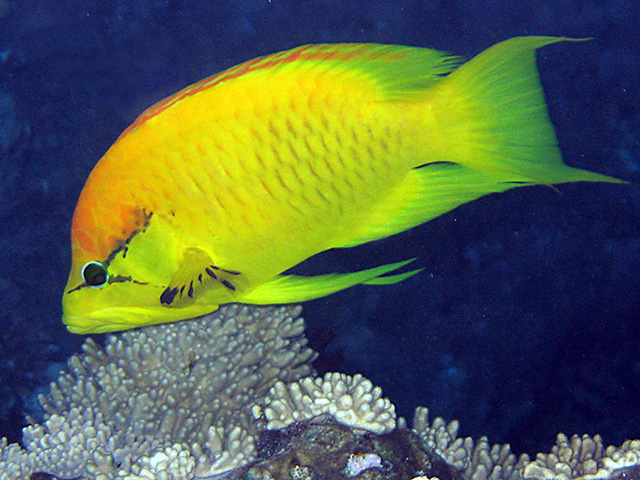| Labridae (Wrasses), subfamily: Cheilininae |
| 54 cm SL (male/unsexed) |
|
reef-associated; marine; depth range 0 - 50 m |
| Indo-Pacific: Red Sea to South Africa (Ref. 35918) and the Hawaiian and Tuamoto islands, north to southern Japan, south to New Caledonia. |
|
Dorsal spines (total): 9-10; Dorsal soft rays (total): 9-11; Anal spines: 3-3; Anal soft rays: 8-9. The mouth of this species is protrusible and unfolds into a tube easily half the body length. The jaws swing forward into a long tube that strong suction to catch prey. When not in use, the entire apparatus is conveniently folded under the head. Small juveniles are brown with thin white bars and closely resemble a species of Wetmorella. Color varies with age and sex, but adult color varies additional, including with an all-yellow xanthic form. Sub adults and females are brown or, not uncommonly, uniformly yellow. Terminal males are dark with a white head and a dark streak extending horizontally through the eye. Male becomes ornamented with orange and yellow over the back. Juveniles dark with fine vertical white lines. Intermediates with yellow blotches, pale tail and sometimes with black pectoral fins (Ref. 48636). |
| Inhabit coral-rich areas of lagoon and seaward reefs (Ref. 1602, 58302). Benthopelagic (Ref. 58302). Generally solitary (Ref. 5213). Feed on small coral-dwelling crustaceans and fishes (Ref. 9710). Capable of drift migration along with floating leaves (Ref. 27153). Adults usually along deep slopes or drop-offs. Sometimes they visit cleaning stations holding their mouth open and out for inspection (Ref. 48636). |
|
Least Concern (LC); Date assessed: 12 July 2008 Ref. (130435)
|
| reports of ciguatera poisoning |
Source and more info: www.fishbase.org. For personal, classroom, and other internal use only. Not for publication.
